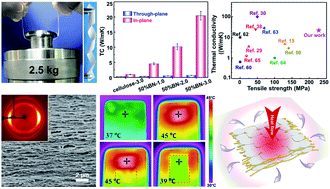Superior strength and highly thermoconductive cellulose/ boron nitride film by stretch-induced alignment†
Abstract
It is still a challenge to realize high mechanical and superior thermal conductive properties simultaneously in one thermal management material. Herein, chemically–physically double cross-linked and stretching orientation strategies were combined to construct a highly ordered cellulose nanofiber network and edge-hydroxylated boron nitride nanosheets (BNNS–OH) structure for fabricating robust cellulose/BNNS–OH composite film with superior thermal conductivity. The aligned regenerated cellulose nanofiber network induced the in-plane orientation of BNNS–OH through covalent and hydrogen bonding interaction. The air-drying densification process was further applied to construct a tightly packed structure for achieving a high tensile strength (226 MPa) and in-plane thermal conductivity (TC, 20.41 W m−1 K−1), which was almost 30 times higher than the through-plane TC (0.69 W m−1 K−1), indicating anisotropic TC properties. The flexible and robust composite film exhibited not only fast heat dissipation for cooling communication devices, but also superior oxygen barrier properties and signal penetration, showing its great potential in communication devices encapsulation. It also provides a novel avenue for preparing highly oriented one-dimensional and two-dimensional composite materials.



 Please wait while we load your content...
Please wait while we load your content...